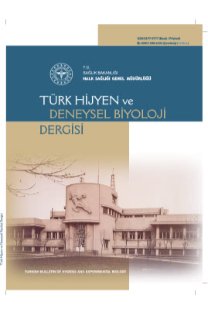Zararlılarla mücadele adı altında semt pazarlarında satılan ürünlerin aktif içeriğinin incelenmesi
Investigation of the active composition of products traded in local street bazaars for pest control
___
- 1. Biyosidal Ürünler Yönetmeliği, Resmi Gazete tarihi/ sayısı: 31 Aralık 2009/27449.
- 2. Bitki Koruma Ürünlerinin Toptan ve Perakende Satılması İle Depolanması Hakkında Yönetmelik, Resmi Gazete tarihi/sayısı: 10.03.2011/27870.
- 3. Tiryaki O, Canhilal R, Horuz S. Tarım ilaçları kullanımı ve riskleri. Erciyes Üniversitesi Fen Bilimleri Enstitüsü Derg, 2010; 26 (2): 154-69.
- 4. Dinçel A, Demli F, Uzun R, Alatan F. Pestisit zehirlenme şüphesi ile gıda toksikolojisi laboratuvarına gönderilen numunelerin GC-MS ile analizi. Türk Hij Den Biyol Derg, 2008; 65 (1): 7-15.
- 5. Uskun E. Tarım çalışanlarının bitki koruma ürünleri konusunda bilgi ve davranışları. Türk Hij Den Biyol Derg, 2015; 72 (3): 241-54.
- 6. Turgut C, Gokbulut C, Cutright TJ. Contents and sources of DDT impurities in dicofol formulations in Turkey. Environ Sci Pollut Res, 2009; 16 (2): 214-7.
- 7. Qiu X, Zhu T. Using the o,p′-DDT/p,p′-DDT ratio to identify DDT sources in China. Chemosphere, 2010; 81 (8): 1033-8.
- 8. Turgut C, Cutright TJ, Mermer S, Atatanır L, Turgut N, Usluy M, et al. The source of DDT and its metabolites contamination in Turkish agricultural soils. Environ Monit Assess, 2013; 185 (2): 1087-93.
- 9. Bosch C, Grimalt JO, Fernández P. Enantiomeric fraction and isomeric composition to assess sources of DDT residues in soils. Chemosphere, 2015; 138: 40-6.
- 10. Can-Güven E, Bolat D, Çelik H, Kurt-Karakuş PB, Gedik K. Semt pazarlarında satılan zararlı canlılarla mücadele ilaçlarından kaynaklanan gizli tehlike. Türk Toksikoloji Derneği III. Bölgesel Toksikoloji Sempozyumu. Haziran, 12-14, İzmir-Türkiye. 2014.
- 11. Cok I, Yelken C, Durmaz E, Uner M, Sever B, Satır F. Polychlorinated biphenyl and organochlorine pesticide levels in human breast milk from the Mediterranean city Antalya, Turkey. Bull Environ Contam Toxicol,, 2011; 86 (4): 423-7.
- 12. Özkaya G, Çeliker A, Koçer-Giray B. İnsektisit zehirlenmeleri ve Türkiye’deki durumun değerlendirilmesi. Türk Hij Den Biyol Derg, 2013; 70 (2): 75-102.
- 13. Płonka M, Walorczyk S, Miszczyk M. Chromatographic methods for the determination of active substances and characterization of their impurities in pesticide formulations. Trends in Analytical Chemistry, 2016; in press, doi: 10.1016/j.trac.2016.03.011.
- 14. Musa U, Hati SS, Mustapha A, Magaji G. Dichlorvos concentrations in locally formulated pesticide (Ota-piapia) utilized in Northeastern Nigeria. Sci Res Essays, 2010; 5 (1): 49-54.
- 15. Ofordile PC, Okoye PAC, Raphael P. Determination of actual chemical composition of a locally formulated pesticide product in a Nigerian market. IJST, 2014; 3 (4): 244-7.
- 16. Ofordile PC, Okoye PAC, Abugu OH, Rafael P. Comparative analysis of some brands of pesticides utilized in Eastern Nigerian environment. IJIRD, 2014; 3 (3): 506-11.
- 17. Lozowicka B, Ilyasova G, Kaczynski P, Jankowska M, Rutkowska E, Hrynko I, et al. Multi-residue methods for the determination of over four hundred pesticides in solid and liquid high sucrose content matrices by tandem mass spectrometry coupled with gas and liquid chromatography. Talanta, 2016; 151: 51-61.
- 18. USEPA. Chemicals Evaluated for Carcinogenic Potential. U.S. Environmental Protection Agency. Science Information Management Branch, Health Effects Division, Office of Pesticide Programs. 2004.
- 19. Rauh VA, Perera FP, Horton MK, Whyatt RM, Bansal R, Hao X, et al. Brain anomalies in children exposed prenatally to a common organophosphate pesticide. Proc Natl Acad Sci USA, 2012; 109 (20): 7871-6.
- 20. USEPA. Human Health Risk Assessment Chlorpyrifos. US Environmental Protection Agency Office of Pesticide Programs. 2000:EPA QA/G-9, QA00 Version, Washington.
- 21. Fenske RA, Black KG, Elkner KP, Lee CL, Methner MM, Soto R. Potentia l exposure and health risks of infants following indoor residential pesticide applications. Am J Public Health, 1990; 80 (6): 689- 93.
- 22. USEPA. US Environmental Protection Agency Office of Pesticide Programs Reregistration Eligibility Decision for Chlorpyrifos. İnternet adresi: https:// www3.epa.gov/pesticides/chem_search/reg_ actions/reregistration/red_PC-059101_1-Jul-06. pdf. Erişim tarihi:14.06.2016.
- 23. Gıda, Tarım ve Hayvancılık Bakanlığı, Gıda ve Kontrol Genel Müdürlüğü, Bitki Koruma Ürünleri Daire Başkanlığı, Chlorpyrifos-ethyl ile ilgili karar. İnternet adresi: https://bku.tarim.gov.tr/Duyuru/ DuyuruDetay/1. Erişim tarihi:10.06.2016.
- 24. Dere E, Özdikicioğlu F, Tosunoğlu H. İntraperitonal diklorvos uygulamasının sıçanların (Rattus norvegicus) bazı dokularında glukoz 6-fosfat dehidrogenaz ve malat dehidrogenaz aktiviteleri üzerine etkisi. Uludağ Üniversitesi Tıp Fakültesi Dergisi, 2007; 33 (1): 5-10.
- 25. USEPA. Summary Document Registration Review: Initial Docket. United States Environmental Protection Agency. İnternet adresi: https://www. regulations.gov/#!documentDetail;D=EPA-HQOPP-2009-0209-0003. Erişim tarihi:14.06.2016.
- 26. Gıda, Tarım ve Hayvancılık Bakanlığı, Yasaklanan Bitki Koruma Ürünleri Aktif Madde Listesi. İnternet adresi: http://wwwtarimgovtr/Konu/934/ Yasaklanan-Bitki-Koruma-Urunleri-Aktif-MaddeListesi. Erişim tarihi:24.04.2015.
- 27. USEPA. Illegal Pesticide Products. United States Environmental Protection Agency. İnternet adresi: http://www.epa.gov/pesticides/health/ illegalproducts/#pet. Erişim tarihi:25.04.2015.
- 28. Ogunniyi DS. Castor oil: a vital industrial raw material. Bioresour Technol, 2006; 97 (9): 1086-91.
- 29. Methyl mercaptan [MAK Value Documentation, 2003]. The MAK Collection for Occupational Health and Safety. Wiley-VCH Verlag GmbH & Co. KGaA. 2012; 218-26.
- 30. Wang T, Bo P, Bing T, Zhaoyun Z, Liyu D, Yonglong L. Benzene homologues in environmental matrixes from a pesticide chemical region in China: occurrence, health risk and management. Ecotoxicol Environ Saf, 2014; 104C (1): 357-64.
- 31. Alyüz B, Veli S. İç ortam havasında bulunan uçucu organik bileşikler ve sağlık üzerine etkileri. Trakya Univ J Science. 2006; 7 (2): 109-16.
- ISSN: 0377-9777
- Başlangıç: 1938
- Yayıncı: Türkiye Halk Sağlığı Kurumu
Rüştü TAŞTAN, Levent ALTINTAŞ, Sibel CEVİZCİ
Nedim ÇAKIR, meryem güvenir, Umut GAZİ, Emrah RUH, Kaya SÜER
Alignment of new bathing water EU directive and its applications to protect public health
Kırmızı biberde aflatoksin oluşturmayan Aspergillus flavus izolatlarının belirlenmesi
Mehmet KOÇ, Bekir Bülent ARPACI, Kerim KARATAŞ, Peter J. COTTY, Ayhan AK
Vorikonazol ile tedavi edilen bir Aspergillus flavus kompleks keratit olgusu
Özlem Evren KEMER, Gülşen HAZIROLAN, Dilay ÖZEK, Altan AKSOY, Neriman AKSU
Kurşun maruziyetinin taranmasında saç ve idrar numunelerinin kullanılabilirliğinin araştırılması
Müjgan ERCAN, Fatma Meriç YILMAZ, Oya TORUN-GÜNGÖR, Engin TUTKUN, Murat BÜYÜKŞEKERCI, Ceylan BAL
Dilek KANYILMAZ, Yakup GÜRKAN, İpek MUMCUOĞLU, Yasemin GENÇ, Altan AKSOY, Neriman AKSU
Nilgün ÖZBEY, Müşerref TATMAN-OTKUN
Farklı biyolojik organizmalarda proteomik uygulamalar
Hatice YILDIZHAN, Demet CANSARAN-DUMAN, Sinem ÖZENOĞLU, Duygu ÖZEL-DEMİRALP
